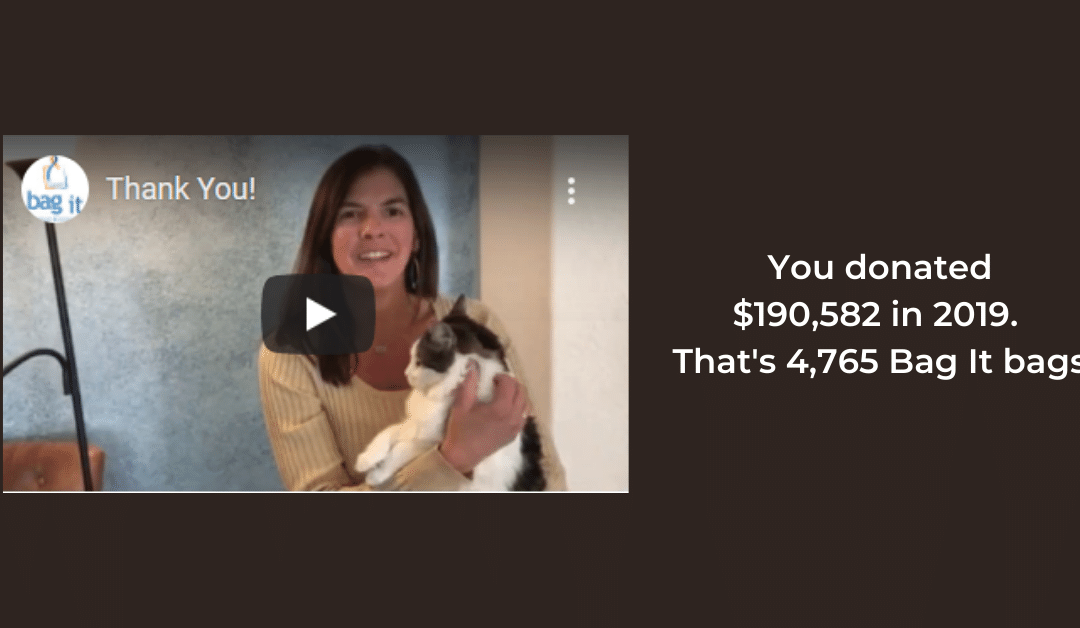
by Bag It Team | Jan 25, 2020 | Videos, What's New
2019 Donations

Thank you to everyone for their 2019 donations to Bag It. We are so appreciative of all of you and your generosity to helping those with cancer. You donated $190,582 last year which provides 4,765 Bag It bags. You are making a difference in the lives of those impacted by cancer!
THANK YOU!
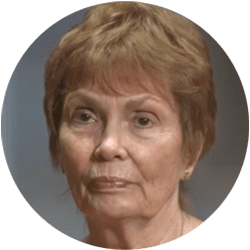
by Bag It Team | Dec 1, 2019 | Blog
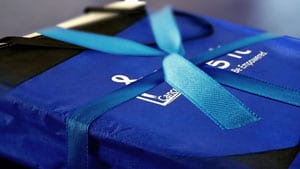 By Ingrid Jacobs
By Ingrid Jacobs
In February 2010, I picked up my Bag It bag at the Resource Center. I was still in shock with my colon cancer diagnosis and was a little dismissive of this bag and its contents.
When I had some quiet time, I looked through it and sorted out those things that directly affected me. By this time I had accumulated a number of providers’ business cards and other information pamphlets that I had in a pile. I also had copies from various doctors of my personal information. This unorganized collection prompted me to look at the binder more closely. Maybe it had something to offer.
The first thing I noticed in the binder was the clear plastic 10 pocket sheet that is intended for business cards. Yeah, I had plenty of those to fill the front and back of almost every pocket. That stayed right up front in my version of the binder. I often wished that I had a couple of those.
There was the encouraging letter from Sherri Romanoski, the founder of Bag It who had had cancer several years earlier. I think that I appreciate her desire to help more now then when I read her letter back in 2010. There were so many things going through my head at the time of my diagnosis and treatment. There were days I felt crappy. There were days I felt pretty good. I was scared and confused, but through it all, I had an extremely strong determination that kept me focused on what I needed to do. I also had the unwavering support of my daughter, her boyfriend, my 2 cats and a dog, a few cousins, and quite a few friends.
The various tabs in the binder caught my attention: Personal Information, Notes/Log/Calendar, Reports/Scans, Labs, and After Treatment. I had something for just about every tab. Hmmmm. . . not half bad. Somebody had put some real thought into this goody binder. I soon found myself putting papers behind the corresponding tabs. Then, I started to personalize it to fit my needs. I created my own tabs. Now I have my dated Chemo Logs and my Post-Chemo Logs. In between my chemo sessions I kept a log of what I was noticing, what I was doing to help myself, and questions I wanted to ask. Every two weeks, I took a copy of this log to my doctor to put into my file. She said that it was very helpful for her to read about these things because it actually helped her with my treatment plan.
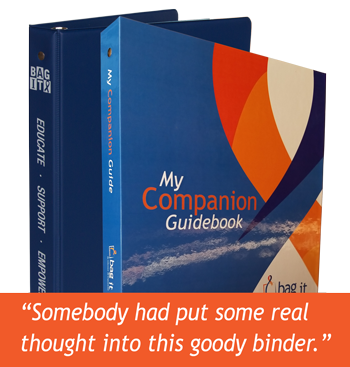 Eventually, my original binder was bursting at the seams. I bought a second binder and created my own matching covers for both binders. I labeled them Arizona Oncology Logs and Labs #1 and #2. I know . . . clever and original. (giggle)
Eventually, my original binder was bursting at the seams. I bought a second binder and created my own matching covers for both binders. I labeled them Arizona Oncology Logs and Labs #1 and #2. I know . . . clever and original. (giggle)
From my doctor, I learned that diet (including vitamins and supplements) was very important for more positive treatment results. I created a 3rd binder with corresponding information. That’s a whole other part of the continuing saga of me taking better charge of my health.

by Bag It Team | May 20, 2019 | Blog
By Friend of Bag It
Recently, my older widowed neighbor was diagnosed with cancer. She was shocked by her diagnosis and knew nothing about cancer because “no one in the family had cancer.” I offered to accompany her on her upcoming appointments as another pair of ears and a scribe. This began a journey where I learned, first-hand, how hard it is to manage this diagnosis, and how incredibly important the right tools and the right information can be. I knew how her soon-to-be-received bag could help Mary and her family through this difficult time, and that put a smile on my face. The solid cancer information found in the printed pubs and reliable cancer websites found in the resources section of the binder and Bag It’s website will help them navigate during and after treatment.

On appointment day we had to arrive 30 minutes early for Mary to deal with the sheaf of paperwork that greeted her. Her cancer pain visible on her face, it was a struggle for Mary to fill out her extensive medical history from memory. While Mary had received a full printed list of her meds from her smart PCP, she could not find it in her wallet. As I sat there watching her try to recall all the names and doses of the meds she took, I visualized how much easier and less stressful it would have been for Mary if she could have just copied all of her personal medical information from the pre-filled forms in her Bag It binder onto the provider’s forms. 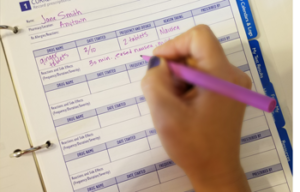 Ten minutes tops. As it turned out the forms were incomplete when we were called into the exam room 45 minutes later. The MA filled in some of the gaps. The kind doctor confirmed the cancer diagnosis, specifying the location, stage and grade of the tumor. It was described as an “aggressive” cancer, and surgery was necessary. A sentinel node biopsy would determine the extent of the surgery. The need for chemotherapy and/or radiation would be known after the full pathology results were in. The doctor spoke in a straightforward manner that provided the basic facts without much elaboration. Things moved quickly as surgery timing and next steps were discussed. Mary posed one or two questions about post-op home care needs but nothing about her cancer or treatment – she didn’t know what to ask.
Ten minutes tops. As it turned out the forms were incomplete when we were called into the exam room 45 minutes later. The MA filled in some of the gaps. The kind doctor confirmed the cancer diagnosis, specifying the location, stage and grade of the tumor. It was described as an “aggressive” cancer, and surgery was necessary. A sentinel node biopsy would determine the extent of the surgery. The need for chemotherapy and/or radiation would be known after the full pathology results were in. The doctor spoke in a straightforward manner that provided the basic facts without much elaboration. Things moved quickly as surgery timing and next steps were discussed. Mary posed one or two questions about post-op home care needs but nothing about her cancer or treatment – she didn’t know what to ask.
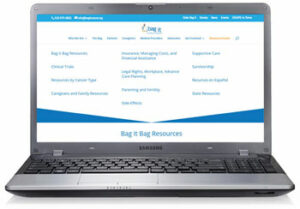 Since then, I think about all the ways Mary could have benefited from receiving a Bag It bag at the initial time of diagnosis or during this early appointment. From the forms, calendars and glossary of basic cancer terms in the navigation binder to the printed pubs with tips on how to prepare for appointments/questions to ask about diagnosis/treatment, ways for patients and families to cope with their diagnosis, how to be an active member of their health care team, and so much more. The Bag It resource center on the website offers more than 150 reliable sites for patients and their families to find credible information and resources right when they need it. Topics include cancer types, clinical trials, side effects, supportive care/emotional support, caregivers and family resources, insurance, and financial assistance, legal rights, advance care planning, and survivorship. Check it out These advantages also serve the healthcare team as Mary would have the tools and knowledge to be more prepared, organized, and better informed. By using her Bag It bag Mary would ideally take a more active role in advocating for herself and likely improve her quality of life as a result. The early window of opportunity to provide a Bag It bag can easily be missed for a variety of reasons but remember it is helpful at any point in the continuum of care and for any type of cancer.
Since then, I think about all the ways Mary could have benefited from receiving a Bag It bag at the initial time of diagnosis or during this early appointment. From the forms, calendars and glossary of basic cancer terms in the navigation binder to the printed pubs with tips on how to prepare for appointments/questions to ask about diagnosis/treatment, ways for patients and families to cope with their diagnosis, how to be an active member of their health care team, and so much more. The Bag It resource center on the website offers more than 150 reliable sites for patients and their families to find credible information and resources right when they need it. Topics include cancer types, clinical trials, side effects, supportive care/emotional support, caregivers and family resources, insurance, and financial assistance, legal rights, advance care planning, and survivorship. Check it out These advantages also serve the healthcare team as Mary would have the tools and knowledge to be more prepared, organized, and better informed. By using her Bag It bag Mary would ideally take a more active role in advocating for herself and likely improve her quality of life as a result. The early window of opportunity to provide a Bag It bag can easily be missed for a variety of reasons but remember it is helpful at any point in the continuum of care and for any type of cancer.
by Bag It Team | Feb 1, 2019 | Podcasts
Check out this podcast on Mrs.Green’s World, as Down to Earth Host, Gina Murphy Darling, talks to Bag it’s Executive Director, Mindy Griffith about the all new Bag It bag and being part of sustainable communities. #BeInformed #BeEmpowered.
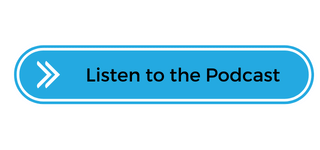




 By Ingrid Jacobs
By Ingrid Jacobs Eventually, my original binder was bursting at the seams. I bought a second binder and created my own matching covers for both binders. I labeled them Arizona Oncology Logs and Labs #1 and #2. I know . . . clever and original. (giggle)
Eventually, my original binder was bursting at the seams. I bought a second binder and created my own matching covers for both binders. I labeled them Arizona Oncology Logs and Labs #1 and #2. I know . . . clever and original. (giggle)

 Ten minutes tops. As it turned out the forms were incomplete when we were called into the exam room 45 minutes later. The MA filled in some of the gaps. The kind doctor confirmed the cancer diagnosis, specifying the location, stage and grade of the tumor. It was described as an “aggressive” cancer, and surgery was necessary. A sentinel node biopsy would determine the extent of the surgery. The need for chemotherapy and/or radiation would be known after the full pathology results were in. The doctor spoke in a straightforward manner that provided the basic facts without much elaboration. Things moved quickly as surgery timing and next steps were discussed. Mary posed one or two questions about post-op home care needs but nothing about her cancer or treatment – she didn’t know what to ask.
Ten minutes tops. As it turned out the forms were incomplete when we were called into the exam room 45 minutes later. The MA filled in some of the gaps. The kind doctor confirmed the cancer diagnosis, specifying the location, stage and grade of the tumor. It was described as an “aggressive” cancer, and surgery was necessary. A sentinel node biopsy would determine the extent of the surgery. The need for chemotherapy and/or radiation would be known after the full pathology results were in. The doctor spoke in a straightforward manner that provided the basic facts without much elaboration. Things moved quickly as surgery timing and next steps were discussed. Mary posed one or two questions about post-op home care needs but nothing about her cancer or treatment – she didn’t know what to ask. Since then, I think about all the ways Mary could have benefited from receiving a Bag It bag at the initial time of diagnosis or during this early appointment. From the forms, calendars and glossary of basic cancer terms in the navigation binder to the printed pubs with tips on how to prepare for appointments/questions to ask about diagnosis/treatment, ways for patients and families to cope with their diagnosis, how to be an active member of their health care team, and so much more. The Bag It resource center on the website offers more than 150 reliable sites for patients and their families to find credible information and resources right when they need it. Topics include cancer types, clinical trials, side effects, supportive care/emotional support, caregivers and family resources, insurance, and financial assistance, legal rights, advance care planning, and survivorship.
Since then, I think about all the ways Mary could have benefited from receiving a Bag It bag at the initial time of diagnosis or during this early appointment. From the forms, calendars and glossary of basic cancer terms in the navigation binder to the printed pubs with tips on how to prepare for appointments/questions to ask about diagnosis/treatment, ways for patients and families to cope with their diagnosis, how to be an active member of their health care team, and so much more. The Bag It resource center on the website offers more than 150 reliable sites for patients and their families to find credible information and resources right when they need it. Topics include cancer types, clinical trials, side effects, supportive care/emotional support, caregivers and family resources, insurance, and financial assistance, legal rights, advance care planning, and survivorship. 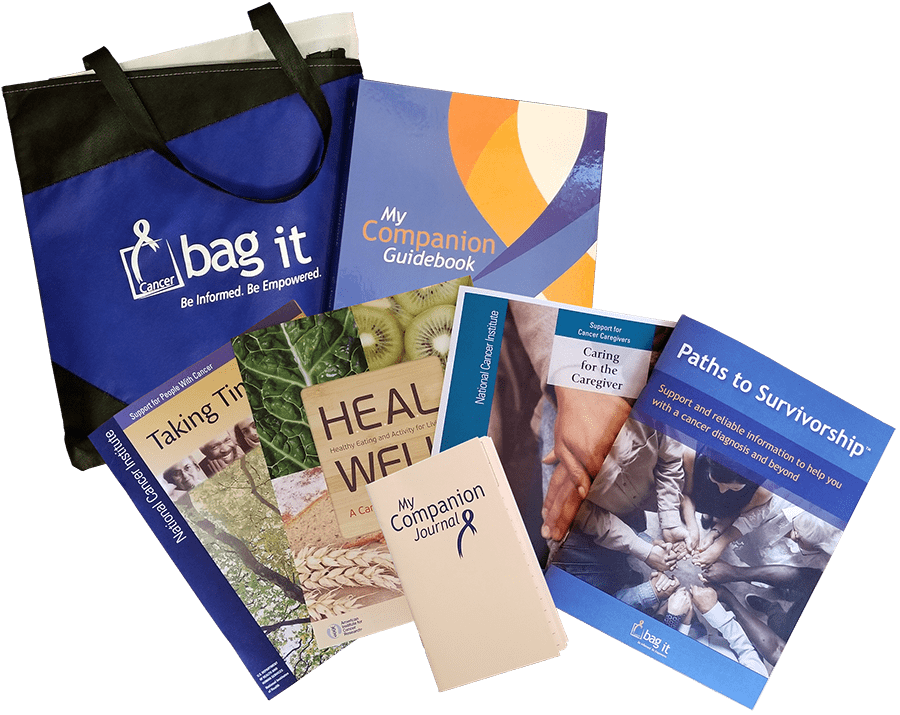

Recent Comments